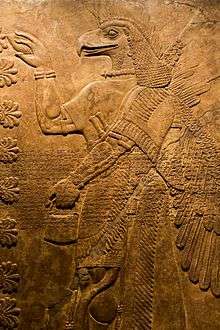Bucket and cone
Bucket and Cone refer to twin attributes that are frequently held in the hands of winged genies depicted in numerous ancient cultures worldwide but particularly and most famously Mesopotamia, particularly in art from Neo-Assyrian Empire (911-605 BCE) and especially Assyrian palace reliefs from this period - sometimes, however, only the bucket is held, and the other hand is held up in what may be a blessing gesture. These objects are often displayed in association with a stylised tree, before floral decorations, guardian figures, the king and / or his attendants and open doorways or portals.[1] The cone was apparently held up in the right hand, the bucket held hanging downwards in the left hand of the figure, which is almost always that of a winged genie or an animal-headed demon or monster (though not necessarily with the same negative connotations) - only very occasionally might these attributes be borne by a fully human figure.

As to the identity of the twin objects, the "cone" is generally recognised as a Turkish pine cone (Pinus brutia), although other common identifications suggest the male inflorescence of the date palm (Phoenix dactylifera), or as a clay model imitating the form of one or the other.[2] The bucket was presumably either of metal or basketry and is thought to have held either water or pollen or both.
Although explanatory texts regarding these objects are exceedingly rare, it does seem likely that they were together employed in rituals of purification, as revealed by their Akkadian (Aka Assyrian, Babylonian) names: 'banddudû' ("bucket") and 'mullilu' ("purifier").[3] In this case the fir cone would be dipped in the bucket of water before being shaken in order to ritually purify a person or object.[4] Alternatively the close association of the objects with depictions of stylised trees has led to the suggestion that it depicts fertilisation.[4] In this case the pollen from the male flower of the date palm would be being shaken onto the tree.[4]
References
| Wikimedia Commons has media related to Bucket and cone. |
- "Sumerian Concepts".
- Walter Reinhold Warttig Mattfeld y de la Torre (2008). "Ezekiel's Cherubim and Ancient Near Eastern Exemplars (9th-6th centuries B.C.)". Bible Origins.
- Collins, Paul (2010). "Attending the King and Eternity". Assyrian Reliefs from the palace of Ashurnasirpal. p. 184. ISBN 978-1-58465-817-7.
- Ataç, Mehmet-Ali (2010). "Time and Eternity". Assyrian Reliefs from the palace of Ashurnasirpal. p. 167. ISBN 978-1-58465-817-7.